Types of Air Conditioners: Choose the Right AC for Your Home
Published: 14 Oct 2025
When the weather gets hot and sticky, an air conditioner feels like a true lifesaver. But did you know that not all air conditioners work the same way? From small window units to fancy smart systems, each type has its own job and benefits. Knowing the different types of air conditioners helps you choose the right one for your home, save energy, and stay comfortable all year round. So, let’s explore these cooling heroes and find out which one fits your space best!
So, are you ready? Let’s see.
Types of Air Conditioners
Air conditioners come in many shapes and styles, each designed to handle different cooling needs. Some are small and perfect for bedrooms, while others can cool an entire home or office. Understanding these types helps you find the one that matches your space, fits your budget, and keeps you comfortable without wasting energy.
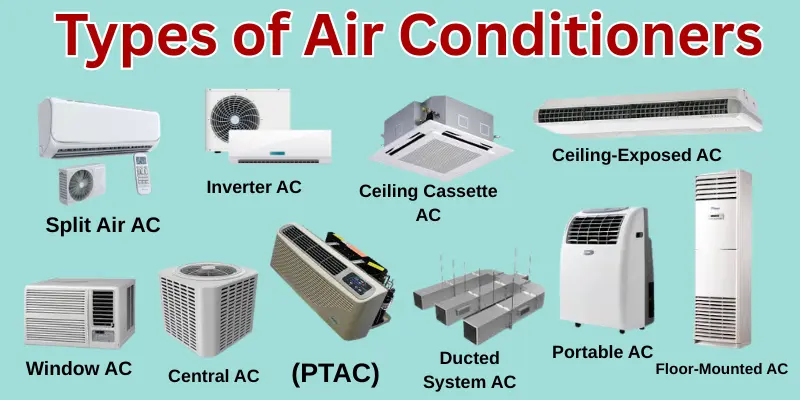
Here’s a list of the main types of AC you’ll come across:
- Window Air Conditioner
- Split Air Conditioner
- Portable Air Conditioner
- Central Air Conditioner
- Ductless Mini-Split Air Conditioner
- Hybrid (Dual Fuel) Air Conditioner
- Geothermal Air Conditioning System
- Floor-Mounted Air Conditioner
- Packaged Terminal Air Conditioner (PTAC)
- Evaporative Air Conditioner / Cooler
- Smart Air Conditioner
- Ceiling Cassette AC
- Ceiling-Exposed AC
- Ducted System Air Conditioner
- Inverter Air Conditioner
Now we will discuss in detail all the air conditioner types on the list one by one. Are you ready? Let’s see.
1. Window Air Conditioner
A window air conditioner is one of the most common and budget-friendly cooling options. It comes as a single compact unit that fits easily into a window or wall opening. This type of AC is great for cooling one small room and doesn’t need any extra installation or parts. It’s simple, affordable, and perfect for homes, hostels, and small offices.
What It Is
A window air conditioner is a single-box cooling system that includes all main parts-compressor, condenser, and coil-inside one unit. It sits half inside and half outside the room, letting it take in warm air, cool it, and release hot air outdoors.
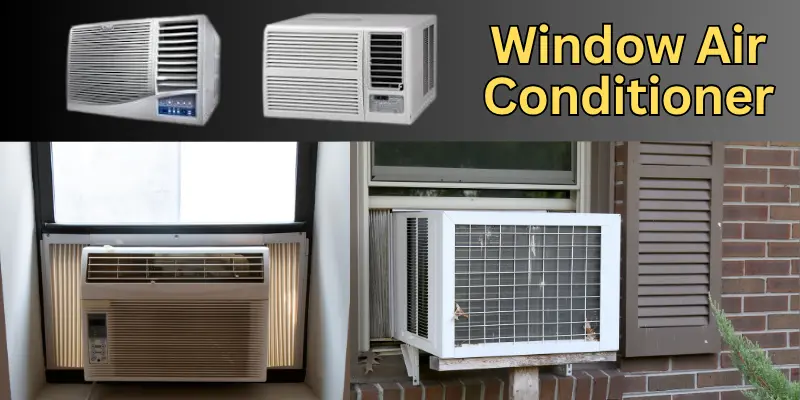
- All parts are built inside one compact box
- Fits easily into a window or wall space
- Used for cooling single rooms
- Simple plug-and-play setup
- Common in small homes and offices
How It Works
This AC takes in warm air from your room and passes it through cooling coils filled with refrigerant gas. The coils absorb the heat and release cool air back into the room, while the hot air moves outside.
- Draws warm air from inside
- Cools it with refrigerant gas
- Circulates cold air into the room
- Pushes hot air outdoors
- Keeps the room temperature stable
Best For
Window ACs are ideal for people who need quick, easy, and cost-effective cooling. They’re perfect for smaller spaces and temporary setups.
- Small bedrooms or study rooms
- Studio or one-room apartments
- Hostel or dorm rooms
- Rented or short-term homes
- Budget-conscious users
Key Features
Window air conditioners include all basic features needed for simple and effective cooling. They are easy to install, control, and maintain.
- Compact and lightweight design
- Adjustable fan speed and temperature
- Removable, washable air filter
- Simple installation without ductwork
- Energy-saving cooling modes
Pros
A window AC offers great value for money and reliable performance for small spaces.
- Affordable and easy to buy
- Quick setup process
- Low maintenance cost
- Saves floor space
- Simple to repair or move
Cons
While window ACs are convenient, they do have a few drawbacks. They’re a bit noisy and not suitable for large spaces.
- Louder operation compared to split ACs
- Blocks part of the window view
- Not ideal for big rooms
- Older models use more energy
- Looks less stylish than newer types
Real-Life Example
If you live in a one-room apartment, just install a window AC in your window, plug it in, and enjoy cool air within minutes. It’s that simple and quick!
- Perfect for students or small families
- Easy to install and remove
- Works well in small, enclosed rooms
- Great for short-term use or rented homes
- Reliable during hot summer months
Expert Tip
To keep your window AC efficient, clean it often and ensure proper sealing around the window.
- Clean the air filter every two weeks
- Seal window gaps to stop hot air leaks
- Avoid blocking the front airflow
- Switch off when not needed to save power
- Service it once before the summer season
A window air conditioner is simple, affordable, and effective -perfect for anyone who needs fast and easy cooling in small spaces.
2. Split Air Conditioner
A split air conditioner is one of the most popular types of ACs used in modern homes. It’s called “split” because it has two main parts – one unit stays inside your room, and the other sits outside. This type of AC is stylish, quiet, and perfect for cooling medium to large rooms. It gives powerful cooling without taking up window space and makes your home look neat and modern.
What It Is
A split air conditioner has two separate units – an indoor unit that blows cool air and an outdoor unit that releases heat. These two parts are connected by pipes that carry refrigerant gas. This setup helps the AC cool your room quietly and efficiently.
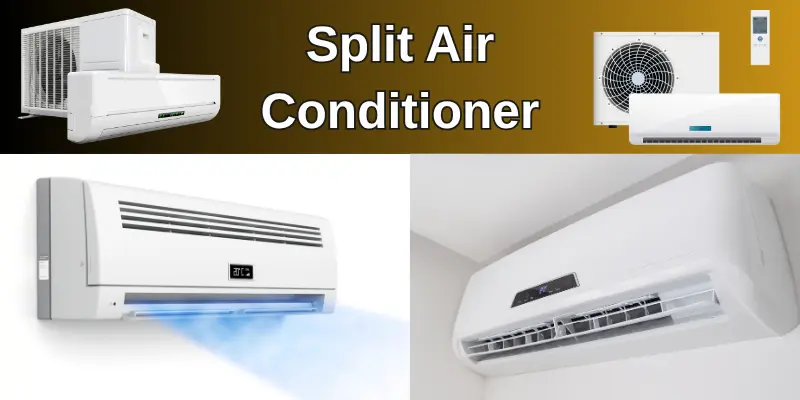
- Indoor unit mounted on the wall
- Outdoor unit installed outside the building
- Linked by copper pipes and wires
- Works quietly without vibration
- Looks clean and modern in design
How It Works
The outdoor unit compresses and cools the refrigerant gas. The cooled gas then travels through pipes to the indoor unit, where it absorbs warm air from your room and blows cool air back inside. The heat from your room is released outdoors through the condenser.
- The outdoor unit cools the refrigerant gas
- Gas moves between the indoor and outdoor units
- Indoor unit absorbs warm air
- Cold air spreads evenly in the room
- Hot air is released outside the house
Best For
Split ACs are best for medium to large spaces where you want powerful, even cooling without much noise. They’re also great for people who care about appearance and comfort.
- Medium and large bedrooms
- Living rooms or drawing rooms
- Offices and meeting halls
- Homes with no window space
- Users who prefer silent operation
Key Features
Split air conditioners come with advanced features for better comfort and energy savings. Many models also include inverter technology and smart controls.
- Sleek indoor wall-mounted design
- Quiet operation with low noise levels
- Remote control and timer settings
- Auto temperature adjustment feature
- Available with an inverter and smart options
Pros
A split AC gives strong, steady cooling and runs quietly. It’s perfect for anyone who wants comfort with style and efficiency.
- Very quiet and smooth operation
- Strong and steady cooling performance
- Saves energy (especially in inverter models)
- No need for large window space
- Increases the home’s modern look
Cons
Though split ACs are efficient, they are costlier than window models and need professional installation.
- Higher price compared to window ACs
- Needs professional setup and servicing
- Not portable or easy to move
- The outdoor unit takes up wall or balcony space
- Repairs can cost more than basic ACs
Real-Life Example
If you have a master bedroom or a living room, a split AC is a smart choice. It gives strong cooling without much noise, and its stylish design fits any interior.
- Ideal for family rooms and bedrooms
- Keeps large rooms evenly cool
- Looks elegant on the wall
- Works quietly while you sleep
- Great choice for long-term use
Expert Tip
To keep your split AC in top condition, clean the filters often and check for gas leaks during servicing.
- Clean air filters every 15 days
- Keep the outdoor unit dust-free
- Check refrigerant level yearly
- Avoid covering the outdoor unit
- Service it before each summer season
A split air conditioner is stylish, quiet, and powerful, the perfect choice for anyone who wants long-lasting, energy-efficient cooling with modern comfort.
3. Portable Air Conditioner
A portable air conditioner is a flexible cooling option for people who need cooling without a fixed installation. As the name suggests, it’s “portable,” meaning you can move it from one room to another easily. It comes as a single compact unit with wheels at the bottom, so you can roll it wherever you want. It’s perfect for renters, small apartments, or places where traditional ACs can’t be installed.
What It Is
A portable air conditioner is an all-in-one cooling system that stands on the floor and connects to a window with a small exhaust hose. It cools the air in your room and sends the hot air outside through the hose.
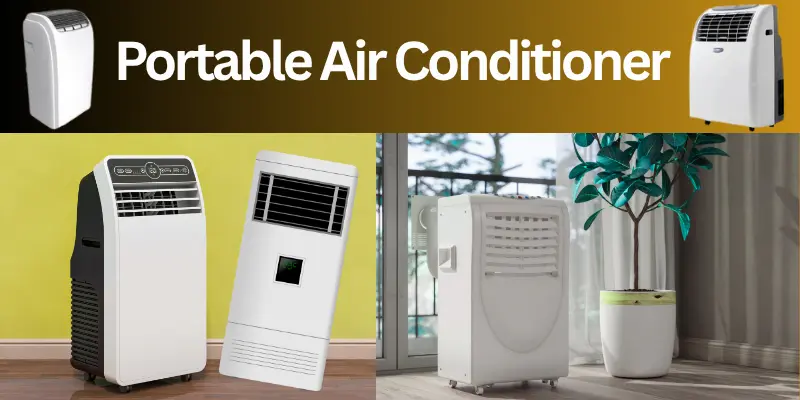
- One compact, movable unit
- No wall or window fitting needed
- Comes with an exhaust pipe for hot air
- Has wheels for easy movement
- Plug-and-play operation for instant cooling
How It Works
The portable AC takes in warm air from your room, cools it using refrigerant, and blows cold air back into the room. The hot air and moisture are released outside through the exhaust hose attached to the window.
- Pulls warm air from the room
- Uses refrigerant gas to cool it
- Blows cool air into the room
- Removes hot air through the exhaust pipe
- Reduces humidity for extra comfort
Best For
Portable air conditioners are great for people who want cooling without any permanent setup. They work best in small to medium rooms or rented places where installation isn’t allowed.
- Small apartments or dorm rooms
- Rented homes or office cabins
- Temporary setups or events
- Spaces with no fixed window or wall
- People who move often
Key Features
Portable ACs come with useful features that make them easy and convenient to use. Some models even include dehumidifiers and remote controls.
- Built-in wheels for easy mobility
- Exhaust hose for hot air release
- Remote and digital control options
- Timer and sleep mode settings
- Some models also remove humidity
Pros
Portable air conditioners are easy to use and require no professional installation. They’re handy, compact, and can be moved wherever cooling is needed.
- Quick setup with no drilling
- Easy to move between rooms
- Ideal for renters or small homes
- Simple to store when not in use
- No need for permanent installation
Cons
While portable ACs are convenient, they’re not as powerful or quiet as fixed systems. They may also take up some floor space.
- Not as cool as split or window ACs
- Slightly noisy while running
- Needs window access for exhaust
- Takes up space on the floor
- Needs regular water drainage or cleaning
You can read our guide to read more about this in detail—Pros and Cons of Portable Air Conditioners.
Real-Life Example
Imagine working in a small office corner or living in a rented apartment – just roll your portable AC next to the window, connect the hose, and enjoy cool air within minutes.
- Great for small rooms or offices
- Perfect for rented homes
- Easy to shift between spaces
- Quick to install and remove
- A smart choice for temporary cooling
Expert Tip
To make your portable AC more efficient, keep the exhaust hose straight and clean the filter regularly.
- Keep the exhaust hose short and straight
- Clean air filters every two weeks
- Drain the water tank when full
- Close doors and windows while using
- Store safely when not in use
A portable air conditioner is a simple, move-anywhere cooling solution – perfect for renters, travelers, and anyone who wants quick, flexible comfort without installation.
4. Central Air Conditioner
A central air conditioner is a powerful cooling system designed to cool an entire house or large building at once. Instead of cooling one room like smaller ACs, it spreads cool air evenly through air ducts installed across the home. It’s a great choice for big families or offices where consistent and whole-house cooling is needed. Though it costs more, it offers comfort, style, and great energy control.
What It Is
A central air conditioner works through a network of ducts that deliver cool air to every room. It has one main outdoor unit that connects to an indoor evaporator coil and blower system. The cool air travels through vents, keeping every corner comfortable.
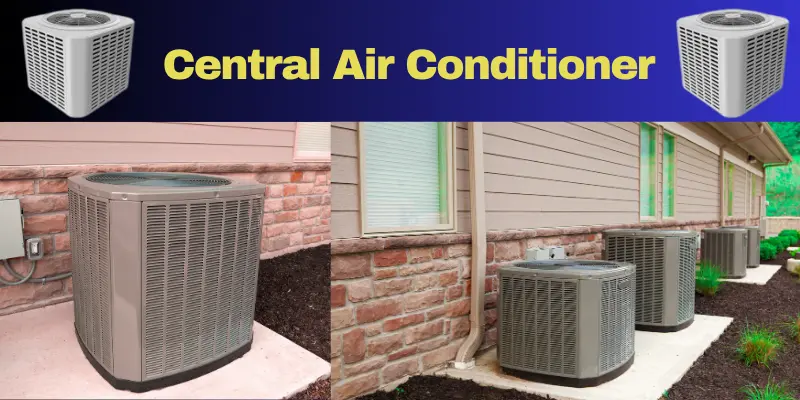
- One large outdoor compressor unit
- Indoor evaporator coil and blower fan
- Network of ducts for air delivery
- Vents spread cool air evenly
- Installed for whole-house cooling
How It Works
The system cools the air at one central location and sends it through ducts into each room. Warm indoor air is drawn in, cooled by refrigerant coils, and then pushed back as chilled air through vents.
- Pulls warm air from rooms through return ducts
- Cools it with refrigerant and evaporator coils
- Distributes cold air through vents
- Keeps indoor temperature balanced
- Uses a thermostat to control cooling levels
Best For
Central ACs are best for large homes, offices, or buildings where you want steady and uniform cooling across multiple rooms.
- Large houses with many rooms
- Office buildings or commercial spaces
- Homes needing hidden or quiet systems
- Families wanting full-home comfort
- People looking for energy control and style
Key Features
This system comes with advanced controls and modern features that ensure consistent comfort. It can also connect with smart thermostats for better energy management.
- Whole-house cooling through ducts
- Smart thermostat compatibility
- Quiet and even air distribution
- High cooling power and speed
- Energy-efficient models available
Pros
Central air conditioners are known for their comfort, convenience, and stylish setup. They cool every room evenly and look neat because everything is built-in.
- Cool the entire home at once
- Silent and smooth operation
- Improves indoor air quality
- Works with smart home systems
- Adds value to your property
Cons
Though very effective, central ACs are expensive to install and need proper maintenance. They’re not ideal for small spaces or rented homes.
- High installation cost
- Needs regular professional servicing
- Not suitable for small houses
- Can increase power bills if overused
- Duct cleaning and maintenance are required
Real-Life Example
If you live in a large house with several rooms, a central AC is the perfect choice. It cools the entire home evenly – no more fighting over which room gets the best air!
- Perfect for big families
- Keeps the temperature even in every room
- Runs quietly in the background
- Smart thermostat adds control
- Great long-term investment
Expert Tip
For best performance, keep the air filters and ducts clean. Also, set your thermostat at an efficient temperature to save energy.
- Clean filters every month
- Service ducts yearly
- Keep the thermostat between 24–26°C
- Check refrigerant levels regularly
- Schedule professional tune-ups
A central air conditioner is the ultimate cooling system for large homes – powerful, quiet, and efficient, offering full-house comfort all year round.
5. Ductless Mini-Split Air Conditioner
A ductless mini-split air conditioner is a flexible and modern cooling system that doesn’t need any air ducts. It has two parts – one outdoor unit and one or more indoor units mounted on the wall. This type is perfect for homes without ductwork or for cooling specific rooms separately. It’s quiet, stylish, and very energy-efficient, making it a favorite in many modern homes.
What It Is
A ductless mini-split system works just like a split AC but without using ducts. The indoor and outdoor units are connected by small pipes that carry refrigerant. Each indoor unit cools one specific area, giving you control over which rooms to cool.
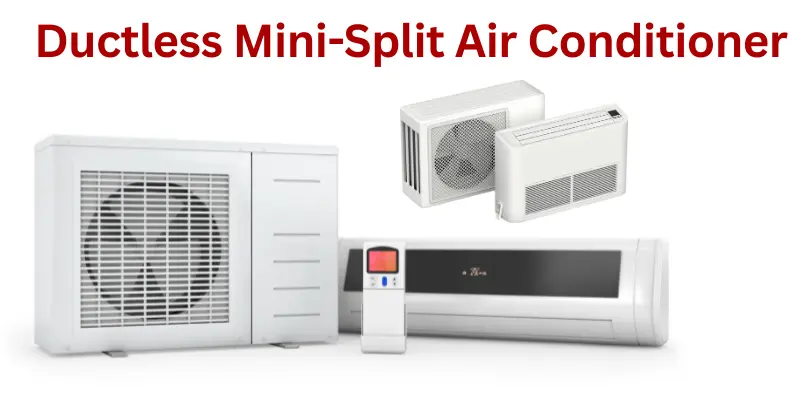
- No ductwork required
- Indoor wall-mounted unit(s)
- Outdoor compressor unit
- Refrigerant pipes connect both units
- Cools individual rooms separately
How It Works
The outdoor unit cools the refrigerant gas and sends it to the indoor unit. The indoor unit then blows cool air into the room. Each indoor unit can work independently, so you can set different temperatures in different rooms.
- The outdoor unit cools the refrigerant
- Cold gas travels through small pipes
- Indoor unit releases cool air
- Each unit works separately
- Saves energy by cooling only used rooms
Best For
Ductless mini-split systems are great for homes without ducts, renovated spaces, or rooms that need independent temperature control.
- Homes without central ducts
- Renovated or extended rooms
- Bedrooms or living rooms
- Small offices or shops
- Energy-conscious homeowners
Key Features
These systems offer high efficiency, flexible installation, and smart controls. Many models also come with heating functions, making them useful in all seasons.
- Independent temperature control for each room
- Smart remote and timer features
- Energy-efficient inverter technology
- Quiet indoor operation
- Both cooling and heating options are available
Pros
Ductless mini-split ACs are efficient and convenient. They save energy and give you complete control over your cooling needs.
- Energy-efficient and cost-saving
- No duct installation needed
- Quiet and stylish design
- Simple temperature control per room
- Easy to install compared to central systems
Cons
Though flexible, ductless systems are more expensive per unit and need professional installation.
- Higher upfront cost
- Needs professional setup
- Wall-mounted units are visible inside rooms
- Regular maintenance of filters is needed
- Not ideal for very large buildings
Real-Life Example
If you have added a new room or converted your garage into a workspace, a ductless mini-split AC is a smart option. It cools the area perfectly without extending any ducts.
- Ideal for added rooms or renovations
- Works great in bedrooms or studios
- Cools areas without affecting others
- Quick and clean installation
- Perfect for energy saving and control
Expert Tip
To keep your mini-split AC working smoothly, clean the filters and keep the outdoor unit clear of dust or leaves.
- Clean indoor filters once a month
- Check for dust on outdoor coils
- Don’t block the indoor airflow
- Use smart controls for better efficiency
- Schedule yearly professional servicing
A ductless mini-split air conditioner gives you quiet, flexible, and energy-saving cooling – perfect for homes without ducts or for cooling specific rooms individually.
6. Hybrid (Dual Fuel) Air Conditioner
A hybrid air conditioner, also called a dual fuel system, is a smart and energy-saving cooling (and heating) option. It combines two systems – an electric air source heat pump and a gas furnace. The system automatically switches between electricity and gas based on which one is more efficient at that time. It helps save energy, reduce bills, and keep your home comfortable all year round.
What It Is
A hybrid air conditioner is a mix of two technologies. It uses electricity for cooling and light heating, and switches to gas when the temperature drops too low. This smart switching gives comfort in all seasons while keeping energy use low.
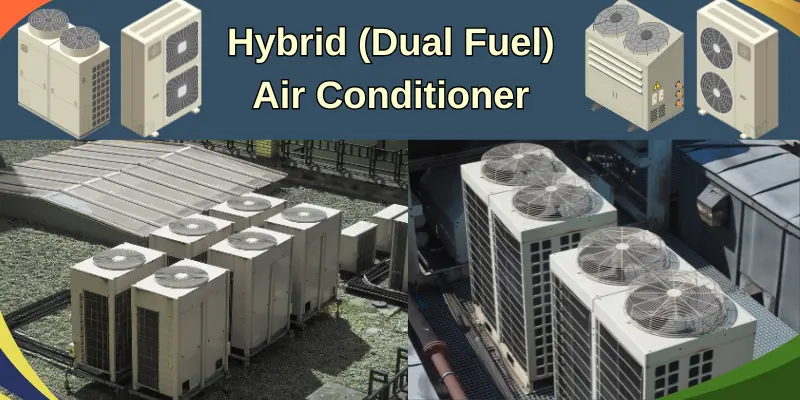
- Combines electric and gas systems
- Works for both cooling and heating
- Switches fuel automatically for efficiency
- Offers comfort all year long
- Reduces overall energy waste
How It Works
The system starts by using the electric heat pump to cool your home during warm weather. When it’s very cold, it switches to the gas furnace to heat your home efficiently. The built-in sensors or thermostat decide which mode to use for best performance.
- An electric heat pump cools during the summer
- Gas furnace heats during cold weather
- Automatic fuel switching based on temperature
- The thermostat controls both systems
- Keeps the indoor climate balanced efficiently
Best For
Hybrid ACs are ideal for areas where temperatures change often, with both hot summers and cold winters. They’re great for families who want year-round comfort with low energy costs.
- Homes in regions with mixed climates
- Medium to large houses
- Families wanting year-round comfort
- People looking to cut energy bills
- Eco-friendly homeowners
Key Features
Hybrid systems are built with advanced controls and energy-saving options. They also allow you to choose when to switch between electric and gas manually.
- Smart automatic switching system
- Works for both heating and cooling
- Programmable thermostat for control
- Energy-saving and eco-friendly design
- Quiet and durable performance
Pros
Hybrid air conditioners provide the best of both worlds – efficiency and comfort. They save money while keeping your home cozy in every season.
- Saves energy by using efficient fuel
- Works well in all weather conditions
- Lowers utility costs over time
- Environment-friendly design
- Long-lasting and reliable system
Cons
While hybrid systems are efficient, they cost more to install and require both electric and gas connections.
- Higher upfront installation cost
- Needs both gas and electric setup
- Professional maintenance required
- Not ideal for very small homes
- May need more installation space
Real-Life Example
If you live in an area with hot summers and chilly winters, a hybrid system can be your best friend. It keeps your home cool in summer and warm in winter – all while saving energy.
- Perfect for regions with all four seasons
- Keeps rooms evenly comfortable
- Switches automatically to save power
- Great for families wanting all-in-one comfort
- Works quietly and efficiently year-round
Expert Tip
To keep your hybrid system working its best, get it serviced regularly and check your thermostat settings for efficiency.
- Schedule yearly professional tune-ups
- Clean or replace filters monthly
- Check both gas and electric parts yearly
- Keep thermostat settings energy-efficient
- Upgrade to a smart thermostat for better control
A hybrid (dual fuel) air conditioner offers smart, year-round comfort by blending electric and gas power – giving you cooling in summer, heating in winter, and savings all the time.
7. Geothermal Air Conditioning System
A geothermal air conditioning system is one of the most advanced and eco-friendly cooling and heating systems. It uses the natural heat stored in the earth to cool or warm your home. The temperature underground stays steady all year, so the system takes advantage of that to work efficiently. It’s quiet, long-lasting, and saves a lot of energy – though it’s expensive to install at first.
What It Is
A geothermal system works by transferring heat between your home and the ground using underground pipes filled with liquid. In summer, it sends the heat from your home into the earth, and in winter, it pulls the earth’s heat inside to warm your home.
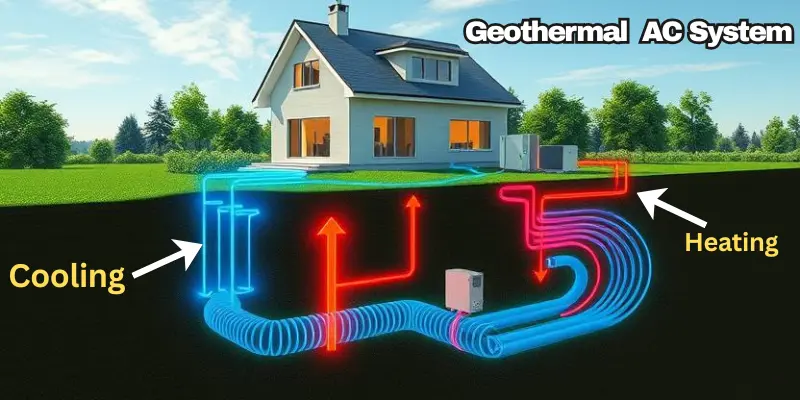
- Uses underground pipes called loops
- Transfers heat between Earth and the home
- Works for both cooling and heating
- Runs quietly and efficiently
- Uses renewable, natural energy
How It Works
The system uses a heat pump connected to buried pipes. During summer, it removes heat from your home and sends it underground. During winter, the process reverses — it collects heat from the earth and brings it inside to warm your home.
- Heat pump connected to underground loop
- Circulating liquid carries heat energy
- Transfers heat to or from the Earth
- Reverses the process for heating or cooling
- Works silently and efficiently year-round
Best For
Geothermal systems are great for homeowners who plan to stay long-term and want an eco-friendly way to heat and cool their homes.
- Large homes or new constructions
- Areas with stable ground conditions
- Eco-friendly families
- Long-term homeowners
- People want low energy bills
Key Features
This system is packed with modern technology and designed for long life and energy efficiency. It also helps reduce your carbon footprint.
- Uses renewable ground energy
- Works as both an air conditioner and a heater
- Extremely quiet operation
- Lasts longer than traditional systems
- Very low monthly energy cost
Pros
Geothermal systems are highly efficient and environmentally friendly. They provide comfort in every season while saving money in the long run.
- Uses clean and renewable energy
- Very low running and maintenance costs
- Provides heating and cooling in one system
- Long lifespan (20–25 years or more)
- Quiet and steady operation
Cons
Although efficient, geothermal systems can be costly to install and require a large area for the underground pipes.
- High initial installation cost
- Needs digging and land space
- Installation takes more time
- Not suitable for all soil types
- Professional setup and service needed
Real-Life Example
If you own a farmhouse or a big property with open land, a geothermal AC system can be an excellent choice. It keeps your home cool in summer and warm in winter with natural earth energy.
- Great for farmhouses and large properties
- Perfect for eco-conscious homeowners
- Works well for all-weather comfort
- Long-term savings on electricity bills
- Runs quietly with little maintenance
Expert Tip
To get the best from your geothermal system, ensure the underground loop is well-installed and maintain your heat pump regularly.
- Hire trained professionals for installation
- Check fluid levels once a year
- Keep the heat pump serviced regularly
- Monitor system efficiency
- Clean filters and ducts as needed
A geothermal air conditioning system uses the earth’s natural energy to provide powerful, quiet, and eco-friendly cooling and heating – perfect for long-term comfort and big energy savings.
8. Floor-Mounted Air Conditioner
A floor-mounted air conditioner is perfect for rooms where you can’t install units high up on the wall or ceiling. It sits near the floor, just like a radiator or heater, and blows cool air straight across the room. It’s easy to access, simple to clean, and great for spaces with low ceilings or slanted walls.
What It Is
A floor-mounted AC works just like a split air conditioner, but is placed lower on the wall or directly on the floor. It has both indoor and outdoor units, but the indoor one is installed close to the ground.
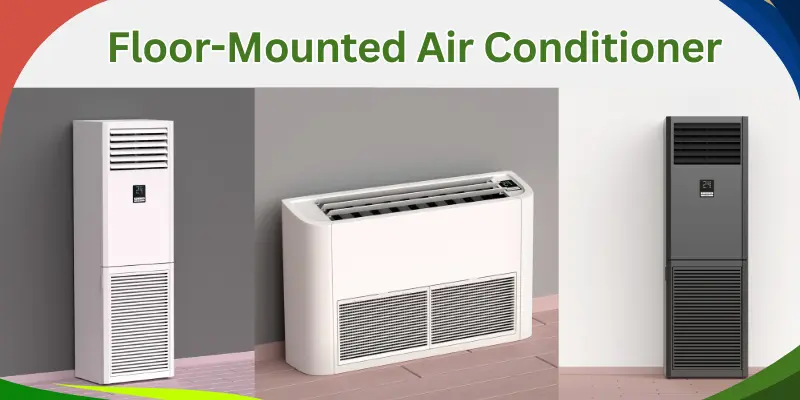
- Installed near the floor or a low wall
- Works like a split system
- Compact and easy to access
- Great for rooms with limited wall space
- Ideal for older buildings or attics
How It Works
This AC pulls in warm air from the bottom of the room, cools it, and sends it back out at floor level. Since cool air naturally rises, it spreads evenly through the space. The outdoor unit handles the heat exchange, just like in other AC systems.
- Draws in warm air from the room
- Cools it using refrigerant
- Blows chilled air across the floor
- Circulates air evenly upward
- Keeps room temperature balanced
Best For
Floor-mounted ACs are great when ceiling or wall installation is difficult. They’re also perfect for people who want easy access to the controls or filters.
- Rooms with low or slanted ceilings
- Old houses without wall support
- Bedrooms and small living spaces
- Spaces with tricky wall designs
- Homes with elderly residents
Key Features
These ACs are easy to install and operate. They cool quickly because they push air directly across the room at body level.
- Fast and even cooling
- Low placement for easy reach
- Compact and space-saving
- Dual fan settings for airflow
- Simple maintenance and cleaning
Pros
Floor-mounted air conditioners are practical, efficient, and perfect for hard-to-fit rooms.
- Great for rooms without ceiling space
- Easy to clean and maintain
- Fast cooling at the body level
- Simple operation and access
- Quiet performance
Cons
Though convenient, they do take up some floor space and may not be ideal for very large rooms.
- Takes up floor or wall space
- Can be blocked by furniture
- Not suitable for big areas
- Slightly less efficient than ceiling units
- May need more cleaning due to dust
Real-Life Example
If you live in a room with a slanted roof or attic ceiling, a floor-mounted AC can keep you cool without needing tricky installations.
- Great for attics or small apartments
- Easy access to controls
- Perfect for elderly users
- No drilling needed in high walls
- Keeps comfort at the body level
Expert Tip
To get the best cooling, make sure no furniture blocks the air vents. Also, clean the lower filters often because they collect dust faster.
- Keep the front area clear
- Clean filters every two weeks
- Schedule regular maintenance
- Avoid blocking airflow with curtains
- Check the outdoor unit for debris
A floor-mounted air conditioner is a smart choice for small rooms, attics, or places without ceiling space – giving cool comfort right where you need it most.
9. Packaged Terminal Air Conditioner (PTAC)
A Packaged Terminal Air Conditioner, or PTAC, is a self-contained cooling and heating system often seen in hotels, hospitals, and offices. It’s usually installed through an exterior wall and provides both cool and warm air. PTACs are reliable, easy to control, and ideal for spaces that need separate temperature settings for each room.
What It Is
A PTAC is a single unit that combines both cooling and heating functions. It’s built to fit into a wall sleeve, with one part facing outside to release heat and the other facing inside to cool or warm the air.
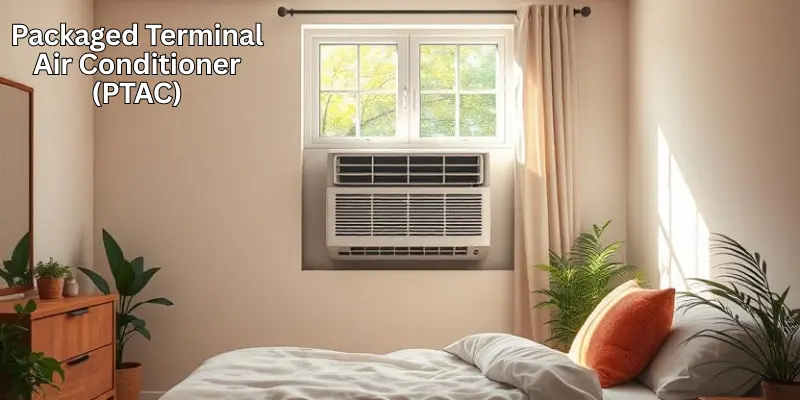
- All-in-one cooling and heating unit
- Installed through an exterior wall
- Common in hotels, offices, and hospitals
- Easy to operate with a control panel
- No need for ducts or multiple units
How It Works
The PTAC unit takes in indoor air, cools or heats it using refrigerant and electric components, and then blows it back into the room. The back part of the unit releases heat outside during cooling and draws it in during heating.
- Draws in air from the room
- Cools or heats using refrigerant
- Blows conditioned air back inside
- Exhausts warm air outdoors
- Works as an independent system
Best For
PTAC units are great for spaces where individual temperature control is needed – such as hotel rooms or offices.
- Hotels and motels
- Hospitals and clinics
- Small offices
- Apartments and dorms
- Guest rooms in homes
Key Features
These systems are known for being simple, independent, and energy-efficient. They can cool or heat one area without affecting others.
- Dual function: heating and cooling
- Wall-mounted, self-contained unit
- Adjustable temperature controls
- Quiet operation
- Easy maintenance and replacement
Pros
PTACs are practical, durable, and easy to manage – perfect for commercial or multi-room spaces.
- Cools and heats in one unit
- Simple installation and maintenance
- Individual room temperature control
- Long-lasting and reliable
- No ductwork required
Cons
Though convenient, PTACs can be noisy at times and may not suit large homes or open spaces.
- Can produce noticeable noise
- Needs a wall opening for installation
- Not suitable for very large rooms
- May dry out indoor air
- Limited design options
Real-Life Example
If you’ve ever stayed in a hotel where you control your own room temperature with a small wall unit, that’s a PTAC! It gives guests comfort and independence without affecting nearby rooms.
- Used in most hotel rooms
- Provides private temperature control
- Great for small offices
- Simple wall-mounted setup
- Reliable for all-year comfort
Expert Tip
To keep your PTAC running efficiently, clean the air filters regularly and make sure the outdoor section is not blocked by dirt or leaves.
- Clean filters every month
- Clear any outdoor obstructions
- Check thermostat settings
- Schedule yearly servicing
- Inspect the drain pan for leaks
A Packaged Terminal Air Conditioner (PTAC) is a compact, all-in-one system that cools or heats single rooms independently – perfect for hotels, offices, and small living spaces.
10. Evaporative Air Conditioner (Cooler)
An evaporative air conditioner, also known as an air cooler or swamp cooler, works differently from regular ACs. Instead of using refrigerant gas, it uses water and evaporation to cool the air. It’s an eco-friendly and cost-effective way to beat the heat, especially in dry and hot areas.
What It Is
An evaporative air conditioner uses natural evaporation to cool the air. It pulls in hot air, passes it through water-soaked pads, and releases cool, moist air into the room.
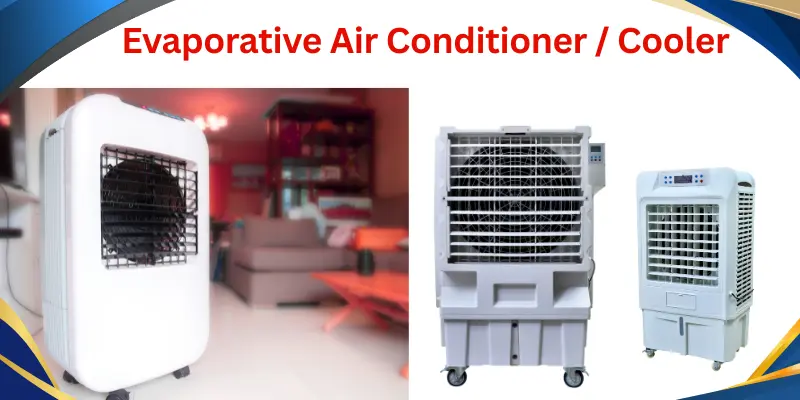
- Works with water instead of refrigerant
- Adds cool moisture to the air
- Uses a simple fan-and-pad system
- Best for dry, low-humidity areas
- Eco-friendly and low energy use
How It Works
The unit has a fan that draws in warm air from outside. This air passes through pads soaked in water, and as it evaporates, the air becomes cooler and fresher before being blown into the room.
- Fan pulls in hot, dry air
- Air passes through wet cooling pads
- Water evaporates and cools the air
- Cooled air spreads across the room
- Constant airflow keeps the space fresh
Best For
Evaporative coolers work best in areas where the air is dry. They’re perfect for homes that need budget-friendly cooling.
- Hot and dry climates
- Open spaces with airflow
- Outdoor patios or workshops
- Small homes or apartments
- Areas with low humidity
Key Features
These coolers are simple, portable, and easy to maintain. They also use very little electricity compared to regular ACs.
- Energy-efficient cooling system
- Adds natural humidity to the air
- Low running and setup costs
- Portable or window-mounted options
- Easy to refill and clean
Pros
Evaporative air conditioners are affordable, eco-friendly, and great for refreshing indoor air naturally.
- Uses less electricity
- Keeps the air moist and fresh
- Easy to move and maintain
- Budget-friendly cooling option
- Great for outdoor or open use
Cons
However, they don’t work well in humid areas and need regular refilling and cleaning.
- Not effective in humid weather
- Needs a constant water supply
- Requires open windows for airflow
- Cooling power is limited
- Can increase room humidity too much
Real-Life Example
If you live in a dry city and need a cool breeze in your living room, an air cooler can do the job without raising your power bill.
- Works great in dry regions
- Ideal for small rooms and balconies
- Uses natural air and water
- Saves money on electricity
- Keeps the air feeling fresh
Expert Tip
Always keep windows slightly open when using an air cooler. This allows hot air to escape and helps the cooler work better.
- Keep windows or doors open
- Clean pads every few weeks
- Refill the water tank regularly
- Use clean water to avoid odor
- Store dry when not in use
An evaporative air conditioner is an eco-friendly, budget cooling option that works best in dry climates – giving you fresh, natural cool air without heavy energy use.
11. Smart Air Conditioner
A smart air conditioner is a modern cooling device that connects to Wi-Fi and can be controlled through your smartphone, tablet, or even voice commands. It’s just like a regular AC but smarter – you can turn it on or off, set temperatures, or schedule cooling even when you’re not home.
What It Is
A smart AC works like a normal split or window air conditioner but includes built-in Wi-Fi or a smart plug that connects to an app. This allows you to monitor and control your AC from anywhere.
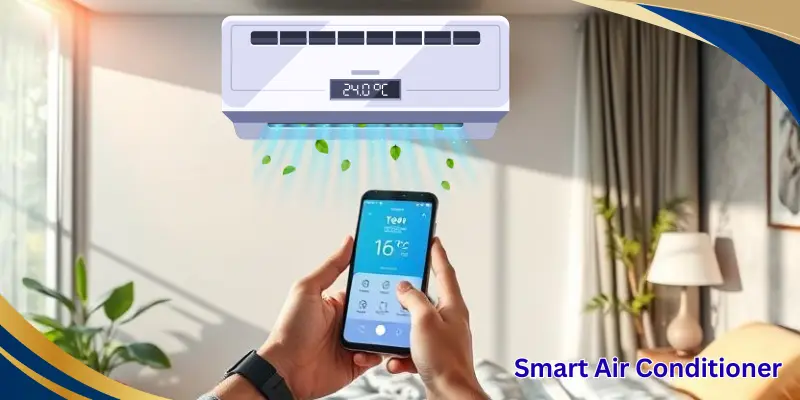
- Wi-Fi-enabled or app-controlled AC
- Works like a normal AC with smart features
- Can connect to voice assistants like Alexa or Google
- Let’s you schedule and track energy use
- Convenient for remote operation
How It Works
The smart AC connects to your home Wi-Fi network. You can use a mobile app to adjust settings, set timers, or even track energy consumption. Some models can also learn your habits and adjust automatically.
- Connects to Wi-Fi for remote access
- Controlled via mobile app or voice commands
- Allows custom cooling schedules
- Tracks usage and temperature patterns
- Sends alerts for cleaning or maintenance
Best For
Smart ACs are ideal for tech lovers, busy families, or anyone who wants comfort and convenience with just a tap on their phone.
- Smart homes and apartments
- Offices with remote management
- Tech-savvy users
- Families with varying schedules
- Energy-conscious homeowners
Key Features
Smart air conditioners come packed with advanced features that make cooling easy, efficient, and fun to manage.
- App and voice control options
- Energy-saving scheduling
- Real-time temperature tracking
- Smart sensors for auto adjustments
- Maintenance reminders and updates
Pros
Smart ACs make life simpler and help save energy by cooling your space only when needed.
- Control anytime, anywhere
- Helps lower electricity bills
- Personalized cooling experience
- Compatible with smart home systems
- Easy monitoring and maintenance
Cons
While convenient, smart ACs can be more expensive and depend on Wi-Fi to function properly.
- Higher cost than normal ACs
- Needs a stable internet connection
- App setup may confuse beginners
- Software updates are sometimes required
- Limited features without Wi-Fi access
Real-Life Example
Imagine you’re coming home on a hot day – with a smart AC, you can turn it on from your phone while you’re still driving. By the time you arrive, your room is cool and comfy!
- Cool your home before arriving
- Adjust the temperature from bed or work
- Control with voice commands
- Set auto-off schedules to save power
- Perfect for modern, connected homes
Expert Tip
To make the most of your smart AC, connect it to your home assistant and set automatic schedules for cooling based on your daily routine.
- Use smart assistants for voice control
- Schedule cooling to match work hours
- Check app updates for new features
- Enable energy-saving mode
- Regularly clean filters for better airflow
A smart air conditioner gives you total control, comfort, and convenience – letting you manage cooling from anywhere while saving energy and time.
12. Ceiling Cassette Air Conditioner
A ceiling cassette air conditioner is a modern and stylish cooling system that’s mounted inside the ceiling. It spreads air evenly in all directions and keeps the room comfortable without taking up wall or floor space. You’ll often see these in offices, shops, and luxury homes because they look neat and work quietly.
What It Is
A ceiling cassette AC is a type of split system where the indoor unit is fixed within the ceiling panel. Only the decorative outer cover is visible, while the main body is hidden above the ceiling. It cools the space evenly with four-way airflow.
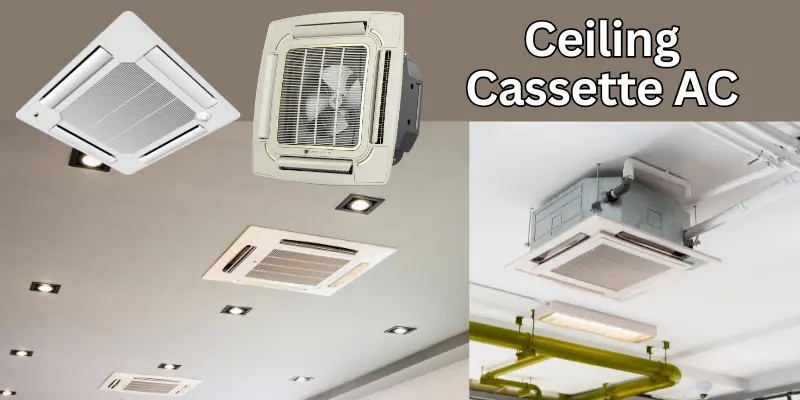
- Installed inside the ceiling
- Uses four-way air distribution
- Works quietly and efficiently
- Hidden design for a neat look
- Perfect for large or open spaces
How It Works
The cassette AC draws warm air from below, cools it through its internal coils, and sends the cool air back down in four directions. The outdoor unit does the heat exchange, just like a regular split AC.
- Pulls warm air upward
- Cools it through refrigerant coils
- Distributes cool air in four directions
- Maintains balanced room temperature
- Uses an outdoor unit for heat release
Best For
Ceiling cassette ACs are best suited for commercial or stylish residential spaces where both even cooling and appearance matter.
- Offices and conference halls
- Restaurants and cafes
- Large living rooms
- Retail shops or showrooms
- Homes with false ceilings
Key Features
This AC is powerful, quiet, and blends with the interior design. It also covers large spaces easily with its multi-directional airflow.
- 4-way air distribution system
- Sleek and hidden ceiling design
- Powerful and quiet operation
- Energy-efficient technology
- Remote or smart control options
Pros
Ceiling cassette ACs provide full-room comfort without affecting your room’s style.
- Even air distribution
- Saves wall and floor space
- Modern and clean look
- Ideal for large rooms
- Quiet and efficient cooling
Cons
Although they look great, installation can be tricky and may cost more compared to standard ACs.
- Requires false ceiling space
- Higher installation cost
- Not ideal for small rooms
- Needs professional maintenance
- Harder to access for cleaning
Real-Life Example
Many restaurants and offices use ceiling cassette ACs because they cool large spaces evenly while keeping the design clean and stylish.
- Common in malls and hotels
- Perfect for meeting halls
- Keeps big areas cool and balanced
- Works silently for comfort
- Blends with modern interiors
Expert Tip
Keep the ceiling vents clean and schedule professional maintenance to ensure proper airflow and long life.
- Clean filters every few weeks
- Check vents for dust or blockage
- Schedule maintenance twice a year
- Keep the ceiling area clear of obstructions
- Monitor for water drips or leaks
A ceiling cassette air conditioner is stylish, quiet, and powerful – ideal for offices, restaurants, and modern homes that need even cooling without cluttering the walls.
13. Ceiling-Exposed Air Conditioner
A ceiling-exposed air conditioner is a strong and stylish cooling system designed for large or open spaces where ceiling installation is possible, but there’s no false ceiling. Unlike cassette ACs that stay hidden, this one is visible – mounted directly under the ceiling. It delivers powerful airflow and is perfect for commercial spaces like shops, restaurants, or halls.
What It Is
A ceiling-exposed AC is a split-type unit where the indoor unit is fixed openly beneath the ceiling. It provides high air throw and wide coverage, making it ideal for cooling large spaces quickly.
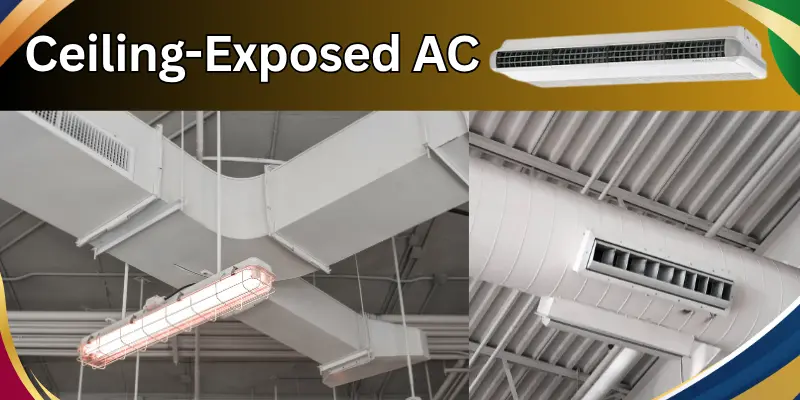
- Mounted openly below the ceiling
- Works as a split-type AC
- Powerful and wide airflow
- No false ceiling needed
- Easy to maintain and service
How It Works
The AC draws in warm air from the room and cools it using refrigerant coils. The cooled air is then pushed out forcefully from the ceiling level, allowing it to spread evenly across the room. The outdoor unit handles the heat exchange process.
- Pulls in warm indoor air
- Cools air through the refrigerant cycle
- Blows cool air strongly across the room
- Covers large areas evenly
- Uses an outdoor unit for heat release
Best For
Ceiling-exposed ACs are great for commercial or large public spaces where high airflow is needed and design isn’t limited by walls or ceilings.
- Restaurants and cafés
- Retail stores or showrooms
- Warehouses or workshops
- School classrooms or halls
- Open-plan offices
Key Features
These ACs combine power, design, and convenience. They’re built to cool wide areas quickly and evenly.
- High air throw and fast cooling
- No false ceiling required
- Sleek, modern body design
- Easy cleaning and access
- Long-lasting and durable motor
Pros
Ceiling-exposed ACs are powerful and efficient for big spaces that need strong and steady cooling.
- Ideal for wide, open spaces
- Quick and effective cooling
- Easy installation and servicing
- Durable and long-lasting build
- Stylish, modern appearance
Cons
While efficient, these units can be noisy and may not suit small or low-ceiling rooms.
- Slightly louder than other types
- Not suitable for small spaces
- Needs strong ceiling support
- Can affect room aesthetics
- Higher power use for big areas
Real-Life Example
If you’ve ever been to a restaurant or store and noticed a long air unit mounted near the ceiling blowing cool air across the space – that’s a ceiling-exposed AC!
- Used in restaurants and showrooms
- Perfect for tall or wide rooms
- Visible but stylish unit
- Keeps air moving evenly
- Common in commercial areas
Expert Tip
Ensure that the ceiling structure is strong enough to hold the unit’s weight, and clean the vents regularly for better airflow.
- Check the ceiling support before installation
- Clean vents monthly
- Service twice a year
- Avoid blocking air outlets
- Inspect fan blades for dust buildup
A ceiling-exposed air conditioner is a powerful, open-mounted cooling system that’s perfect for large spaces – offering quick, even cooling without needing a false ceiling.
14. Ducted System Air Conditioner
A ducted system air conditioner is a hidden, whole-house cooling solution that delivers cool air through ducts built into the ceiling or walls. Unlike wall-mounted units, this system keeps everything out of sight – only the vents are visible. It offers powerful, even cooling for large homes, offices, and commercial buildings.
What It Is
A ducted system AC has one central unit connected to a network of ducts that carry cool air to different rooms. The main unit is usually placed in the ceiling or outside, while air vents in each room control the temperature.
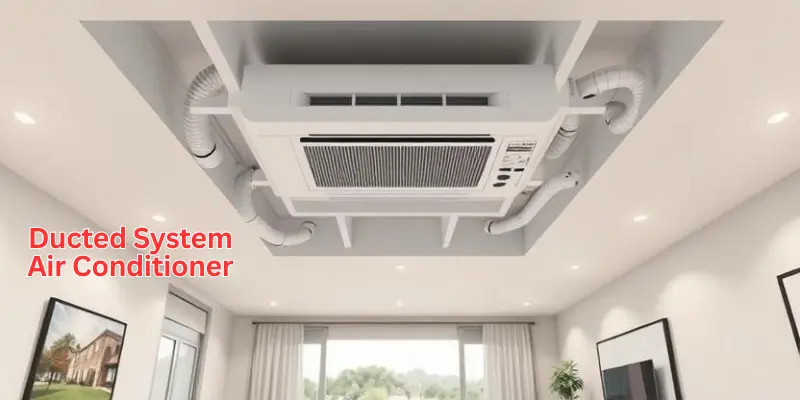
- Central cooling unit with multiple ducts
- Hidden setup for a clean look
- Controls temperature in different rooms
- Installed in the ceiling or under the floor
- Great for large homes or buildings
How It Works
The system cools the air in the main unit and then pushes it through ducts into various rooms. Each room has vents or grilles that let out cool air. The return ducts pull warm air back into the system for re-cooling.
- The central unit cools the air
- Ducts distribute air to rooms
- Vents release cool air evenly
- Return ducts pull warm air back
- Maintains a steady temperature everywhere
Best For
Ducted systems are ideal for places that need complete, even cooling across multiple rooms or large spaces.
- Big homes and villas
- Offices and commercial buildings
- Schools and hospitals
- Shopping malls or restaurants
- Multi-room apartments
Key Features
Ducted air conditioning systems are powerful, quiet, and designed for large-scale comfort.
- Central cooling for multiple rooms
- Hidden ducts and vents
- Quiet and energy-efficient operation
- Zoning control for different areas
- Works for both cooling and heating
Pros
This system offers a clean, elegant look with no visible units, plus consistent temperature across all rooms.
- Uniform cooling throughout the building
- No visible indoor units
- Can cool multiple rooms at once
- Smart zoning for energy saving
- Quiet and efficient performance
Cons
While efficient, ducted systems can be expensive and complex to install and maintain.
- High installation and setup cost
- Needs ceiling or wall space for ducts
- Professional maintenance required
- Repairs can be time-consuming
- Not ideal for small homes
Real-Life Example
If you’ve ever entered a modern office or hotel where you feel cool air from ceiling vents but see no AC unit – that’s a ducted system at work!
- Common in large offices or malls
- Ideal for whole-home cooling
- Hidden, clean look
- Perfect for open or multi-room spaces
- Provides quiet, even comfort
Expert Tip
Always clean and inspect your ducts regularly to prevent dust buildup and ensure smooth airflow.
- Schedule duct cleaning every year
- Check vents for dust or blockage
- Replace filters regularly
- Keep the outdoor unit free of debris
- Get professional maintenance twice a year
A ducted system air conditioner gives complete, hidden, and quiet cooling for large homes or offices – perfect for those who want power and style in one system.
15. Inverter Air Conditioner
An inverter air conditioner is a modern type of AC designed to save energy while keeping your room cool and comfortable. Unlike regular ACs that turn on and off repeatedly, an inverter AC adjusts its speed automatically to maintain the perfect temperature. This means quieter operation, faster cooling, and lower electricity bills.
What It Is
An inverter air conditioner uses advanced compressor technology that can change its speed depending on the cooling need. Instead of switching off once the room is cool, it runs at a lower speed to maintain comfort.
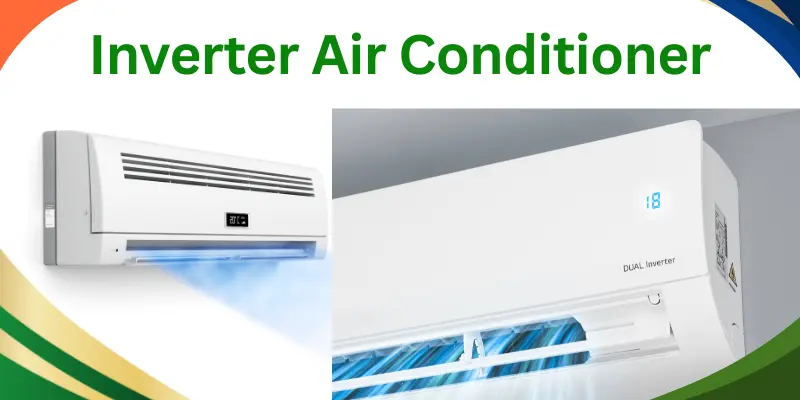
- Uses variable-speed compressor technology
- Adjusts power based on temperature
- Keeps cooling consistently and smoothly
- Works quietly with less vibration
- Saves more energy than regular ACs
How It Works
The inverter AC controls the compressor motor speed using a smart inverter circuit. When the room is hot, the compressor runs fast to cool it quickly. Once the desired temperature is reached, it slows down but keeps running to maintain that level – no frequent starts or stops.
- Compressor speed changes automatically
- Works continuously at low power
- Maintains a steady temperature
- Reduces electricity usage
- Prevents overcooling or overheating
Best For
Inverter air conditioners are ideal for homes, offices, or any place where the AC runs for long hours and energy saving is a priority.
- Homes with frequent AC use
- Offices and small businesses
- Bedrooms and living rooms
- Apartments or compact spaces
- Areas with high electricity costs
Key Features
These ACs are packed with smart and energy-efficient features that make cooling smoother and quieter.
- Energy-saving inverter technology
- Quick and consistent cooling
- Smart temperature control
- Low noise operation
- Long-lasting compressor life
Pros
Inverter air conditioners are highly efficient, comfortable, and built for long-term use.
- Saves up to 30–50% electricity
- Faster cooling with less power
- Quieter than regular ACs
- Steady, comfortable temperature
- Longer life due to smooth operation
Cons
Though efficient, inverter ACs can be more expensive at first and require careful maintenance.
- Higher upfront cost
- Costlier compressor repairs
- Needs a stable power supply
- May require expert servicing
- Not ideal for short, irregular use
Real-Life Example
If you use your AC daily, an inverter AC can help you save on electricity bills while keeping your room cool all day. For example, families who run their AC all night find inverter models much more cost-effective and comfortable.
- Perfect for daily, long-term use
- Keeps the temperature steady all night
- Saves money on monthly bills
- Runs quietly without on-off noise
- Great for both home and office
Expert Tip
To get the most from your inverter AC, keep doors and windows closed while running it and clean filters regularly for smooth airflow.
- Keep the room sealed for better cooling
- Clean air filters every two weeks
- Schedule servicing every six months
- Avoid overloading the power source
- Use energy-saving or eco mode
An inverter air conditioner is smart, quiet, and energy-efficient – perfect for homes and offices that want cool comfort with lower electricity costs.
Which Type of AC Is Best for the House
If you ask me which air conditioner truly stands out, I’d say the Split Inverter Air Conditioner wins my heart every time. 💨 It’s quiet, smart, and unbelievably efficient – the kind of AC that makes your room feel cool and cozy without sending your electricity bill through the roof. I always recommend it because it’s a perfect blend of comfort, style, and savings. Whether it’s a hot summer afternoon or a warm night, this AC keeps your space just right – cool, calm, and comfortable.
Conclusion
In this guide, we explored the different types of air conditioners, from simple window and portable units to advanced split, inverter, and smart systems. Each type works differently and suits different needs – some are perfect for small rooms, while others can cool an entire home or office. Understanding these types helps you choose the right one that fits your lifestyle, saves energy, and keeps your space comfortable all year long.
Choosing the right air conditioner is more than just picking a cooling device – it’s about finding the one that truly matches your comfort and budget. Every type we discussed has something special to offer, so take time to explore them before buying. Personally, I believe the best AC is the one that makes your home feel peaceful, cool, and cozy without using too much power. Once you find that perfect match, every summer will feel like a breeze.
Ready to choose your perfect AC? Start comparing today and enjoy cool comfort all year round!
Common Questions and Answers About Types of AC
When it comes to choosing an air conditioner, people often get confused about which type to buy, how they work, and which one fits their space best. Don’t worry – you’re not alone! Below are some common questions and easy answers to help you understand different types of air conditioners before you make your choice.
A split AC has two main parts – one indoor and one outdoor – which makes it quieter and better-looking. It’s perfect for people who want steady cooling and less noise. A window AC, on the other hand, is a single compact unit that’s easier to install and usually cheaper. However, it can be noisier since all parts are in one body. Both work well, but a split AC gives more comfort and style.
The inverter air conditioner is the top choice for saving power. It adjusts its speed automatically depending on how much cooling your room needs. This means it doesn’t keep turning on and off like old ACs, which reduces power use. Over time, you’ll notice lower electricity bills. It’s a great pick for homes where the AC runs daily.
Portable ACs are easy to move and perfect for small rooms or rented homes. But they aren’t as powerful or energy-efficient as split ACs. They take longer to cool and can be a bit noisy because the motor is inside the room. Still, if you want something quick and flexible without installation, a portable AC works well. Split ACs are better for long-term, everyday cooling.
For a big house, a central or ducted air conditioner is the best option. It cools every room evenly through ducts hidden in the walls or ceiling. These systems are controlled from one place, which makes temperature control very easy. However, they are costly to install and need professional maintenance. But for large spaces, they offer unbeatable comfort.
No, you can’t use a window AC in a room without a window or outlet for hot air. It needs proper ventilation to push warm air outside. Without that, it won’t cool your room and could even overheat. If your room doesn’t have a window, try a split or portable AC instead. These types don’t need a window to work efficiently.
An inverter AC changes its compressor speed automatically based on the room temperature. This keeps your cooling steady and saves a lot of power. A non-inverter AC turns on and off again and again, using more energy. That’s why inverter models are more efficient, quieter, and last longer. Though they cost more upfront, they save money in the long run.
Yes, smart air conditioners are worth it if you love convenience and technology. They connect to Wi-Fi, so you can control them from your phone or even by voice. You can adjust the temperature, turn it off, or set timers from anywhere. They also help save energy by letting you monitor usage. If you want comfort and control, smart ACs are a great choice.
A hybrid or dual-fuel AC uses both electricity and gas to cool or heat your home. It automatically switches between the two to save energy depending on the weather. This makes it very efficient all year round. However, installation can be expensive, so it’s more common in larger homes. It’s a smart choice if you want one system for both heating and cooling.
Most air conditioners last between 10 to 15 years when properly maintained. Regular cleaning of filters and timely servicing can extend their lifespan. Using your AC wisely and not overloading it also helps. Inverters and branded models often last longer because of better technology. Always check warranty terms before buying to know what’s covered.
Window and portable air conditioners are the easiest to install. You can set them up quickly without needing a professional. Split, ducted, or central systems need expert installation but offer better performance and look neater. If you move often or live in a rental home, go for portable or window types. They’re simple, convenient, and ready to use in minutes.
If you enjoyed learning about the types of AC, you’ll love our next guide on refrigerator types. It explains everything in simple words and answers many common questions people have.





